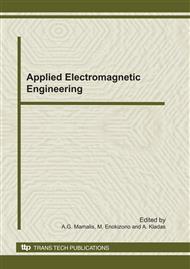[1]
J. Rabinow, The magnetic fluid clutch, AIEE Trans., vol. 67, pp.1308-1315, (1948).
Google Scholar
[2]
M. R. Jolly, J. D. Carlson and B. C. Munoz, A model of behavior of magnetorheological materials, Smart Mater. Struct., vol. 5, pp.607-614, (1996).
Google Scholar
[3]
P. Goldberg, J. Handford and P. Heerden, Polarization of light in suspensions of small ferrite particles in a magnetic field, J. Appl. Phys., vol. 42, pp.3874-3876, (1971).
DOI: 10.1063/1.1659700
Google Scholar
[4]
A. Jozefczak, The time dependence of the changes of ultrasonic wave velocity in ferrofluid under parallel magnetic field, J. Magn. Magn. Mater., vol. 256, pp.267-270, (2003).
DOI: 10.1016/s0304-8853(02)00572-3
Google Scholar
[5]
M. Motozawa and T. Sawada, Influence of magnetic field on ultrasonic propagation velocity in magnetic fluids, J. Magn. Magn. Mater., vol. 289, pp.66-69, (2005).
DOI: 10.1016/j.jmmm.2004.11.019
Google Scholar
[6]
M. A. Bramantya, M. Motozawa, H. Takuma, M. Faiz and T. Sawada, Experimental analysis of clustering structures in magnetic and MR fluids using ultrasound, J. Phys.: Conf. Ser., vol 149, no. 012040, pp.1-4, (2009).
DOI: 10.1088/1742-6596/149/1/012040
Google Scholar
[7]
D.Y. Chung, H.Z. Hung and J.X. Lin, Ultrasonic properties of magnetic fluid, J. Magn. Magn. Mater., vol. 39, pp.111-112, (1983).
Google Scholar
[8]
D.Y. Chung and W. E. Isler, Ultrasonic velocity anisotropy in ferrofluids under the influence of a magnetic field, J. Appl. Phys., vol. 49, pp.1809-1812, (1978).
DOI: 10.1063/1.324819
Google Scholar
[9]
D. Y. Chung, J.X. Lin, W.A. Funderburk and J. Popplewell, Electron diffusion in liquid-phase epitaxial p-GaAs: Ge layers determined by electron-beam-induced current method, J. Appl. Phys., vol. 53, pp.1236-1237, (1982).
DOI: 10.1063/1.330536
Google Scholar
[10]
K. Gotoh and D.Y. Chung, Ultrasonic attenuations in magnetic fluids, J. Phys. Soc. Jpn., vol. 53, pp.2521-2528, (1984).
DOI: 10.1143/jpsj.53.2521
Google Scholar
[11]
I.E. Taparov, N.E. Patsegon and A.F. Phedonenko, Some physical and mechanical phenomena in magnetizable fluids, J. Magn. Magn. Mater., vol. 39, pp.51-55, (1983).
DOI: 10.1016/0304-8853(83)90396-7
Google Scholar
[12]
P.C. Jordan, Field dependent chain formation by ferromagnetic colloids, Mol. Phys., vol. 38, pp.769-780, (1979).
DOI: 10.1080/00268977900102031
Google Scholar
[13]
D.Y. Chung, H.Z. Hung and J.X. Lin, Magnetic effects on the ultrasonic velocity and attenuation in magnetic fluids, J. Magn. Magn. Mater., vol. 65, pp.231-234, (1987).
DOI: 10.1016/0304-8853(87)90039-4
Google Scholar
[14]
M.A. Bramantya, H. Takuma and T. Sawada, Ultrasonic study on clustering structures of a magneto-rheological fluid under uniform magnetic fields, J. Jpn. Soc. Appl. Electromag. Mech., vol. 17, pp.99-104, (2009).
Google Scholar


